International Journal of Image, Graphics and Signal Processing @ijigsp
Статьи журнала - International Journal of Image, Graphics and Signal Processing
Все статьи: 1157
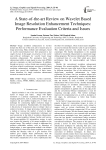
Статья научная
Image resolution enhancement in wavelet domain has been one of the most active research areas in image processing. Many methods and techniques, based on wavelet transformation have been proposed in last couple of years. In this paper, we present a review on the state-of-the-art techniques for wavelet based image resolution enhancement. We summarize them with enhancement ability in peak signal to noise ratio (PSNR) and give comments on their performance. In addition, through our review, we have found some essential criteria and issues related to performance assessment of different resolution enhancement techniques. Our experimental results have proved the significance of these issues. Future directions for image resolution enhancement research are stated at the end.
Бесплатно
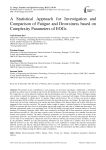
Статья научная
The primary factors contributing to road accidents are drowsiness and fatigue. Additionally, it diminishes productivity within work environments and elevates the likelihood of accidents. The analysis of bio-signals is crucial in the examination of various physical conditions and the physiological state of an individual. Various biological signals were utilized to identify the presence of fatigue and drowsiness that is associated with fatigue. Various physiological signals were employed to identify driver or operator fatigue and drowsiness. Out of all these non-invasive signals, electrooculogram (EOG) exhibits well-accepted outcomes for detecting drowsiness and fatigue. By employing an EOG-based study, the real-time monitoring of the muscle and mental fatigue of the human subject can be done when they are engaging in their everyday activities. The present studies sought to employ a statistical analysis of electrooculograms (EOGs) to ascertain the stress levels of participants and provide insight into their state of fatigue and drowsiness. Two different experimental studies were performed with 120 and 80 healthy male and female research scholars of National Institute of Technology Durgapur, India. EOGs were recorded by the Biopac MP 45 data acquisition system at two and three different sessions of a day with huge cognitive tasks in between. Several entropies are evaluated from the time domain and frequency domain. The others complexity parameters are also incorporated to enrich the results of the experimental processes. An inferential statistical analysis based on the parametric t-test and non-parametric Wilcoxon test for study-I was considered to compare the stress levels between morning and evening sessions. Similarly, in study-II, the parametric ANOVA test and non-parametric Friedman test were carried out to monitor stress level in three different sessions of a day. The Tukey-Kramer post-hoc test is also undertaken to compare the outcomes among three different sessions and find the statistical differences based on a 5% significance level. Most complexity parameters show excellent results and clear differences in fatigue states for both the experiments and these analyses indicates the presence of onset fatigue among the subjects under consideration.
Бесплатно
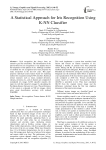
A Statistical Approach for Iris Recognition Using K-NN Classifier
Статья научная
Irish recognition has always been an attractive goal for researchers. The identification of the person based on iris recognition is very popular due to the uniqueness of the pattern of iris. Although a number of methods for iris recognition have been proposed by many researchers in the last few years. This paper proposes statistical texture feature based iris matching method for recognition using K-NN classifier. Statistical texture measures such as mean, standard deviation, entropy, skewness etc., and six features are computed of normalized iris image. K-NN classifier matches the input iris with the trained iris images by calculating the Euclidean distance between two irises. The performance of the system is evaluated on 500 iris images, which gives good classification accuracy with reduced FAR/FRR.
Бесплатно
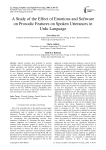
Статья научная
Speech emotions have potential to provide valuable source of information which can lead us toward human perception and decision making process. This paper analyzes the variation and effect on prosodic features (Formant and Pitch) of female and male speakers in two different emotions (angry and neutral) and softwares (PRAAT and MATLAB) in Urdu language using two ways ANOVA testing. The objective of this paper is to determine the significant effect of emotions and softwares on prosodic features (Pitch and Formant) using recorded speech emotion of both male and female voices of same age group in Urdu language. Experimental results of two-way ANOVA testing considerably show that emotions have effect on pitch and formant both in male and female voice unlike software.
Бесплатно
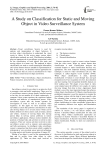
A Study on Classification for Static and Moving Object in Video Surveillance System
Статья научная
Visual surveillance System is used for analysis and interpretation of object behaviors. It involves object classification to understand the visual events in videos. In this review paper various object classification methods are used. Classification technique plays an important role in surveillance system that is used for the classification of both objects like static and moving objects in a better way. The methods in object classification are used to extract meaningful information and various features that are needed for representation of data. In this survey, we described various approaches for moving objects that are used in classification for video surveillance system based on shape and motion.
Бесплатно
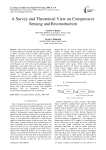
A Survey and Theoretical View on Compressive Sensing and Reconstruction
Статья научная
Most of the current embedded systems operate on digital domain even though input and output is analog in nature. All these devices contain ADC (Analog to Digital converter) to convert the analog signal in to digital domain which is used for processing as per the application. Images, videos and other data can be exactly recovered from a set of uniformly spaced samples taken at the Nyquist rate. Due to the recent technology signal bandwidth is becoming wider and wider. To meet the higher demand, signal acquisition system need to be improved. Traditional Nyquist rate which is used in signal acquisition suggests taking more numbers of samples to increase the bandwidth but while reconstruction most of the samples are not used. If samples are as per Nyquist rate then, this increases the complexity of encoder, storage of samples and signal processing. To avoid this new concept Compressive Sensing is used as an alternative for traditional sampling theory. This paper presents a survey and simplified theoretical view on compressive sensing and reconstruction and proposed work is introduced.
Бесплатно
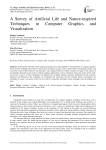
A Survey of Artificial Life and Nature-inspired Techniques in Computer Graphics and Visualization
Статья научная
Artificial life and other nature-inspired techniques have been applied to many problems in computer graphics. Some of these techniques are based on observations of organic systems, such as slime molds and flocking animals, and can mimic some of their behaviors and structures. The emergent behavior of these systems can improve the realism of procedurally-generated assets used in computer graphics applications, such as animation and texture maps. In this work, we provide a survey of these techniques and applications, including cellular automata, differential growth, reaction-diffusion, and Physarum. The techniques are compared and contrasted, and the common themes and patterns are elucidated to create a taxonomy which can be useful to researchers studying existing techniques and developing new ones.
Бесплатно
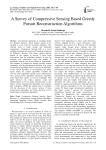
A Survey of Compressive Sensing Based Greedy Pursuit Reconstruction Algorithms
Статья научная
Conventional approaches to sampling images use Shannon theorem, which requires signals to be sampled at a rate twice the maximum frequency. This criterion leads to larger storage and bandwidth requirements. Compressive Sensing (CS) is a novel sampling technique that removes the bottleneck imposed by Shannon's theorem. This theory utilizes sparsity present in the images to recover it from fewer observations than the traditional methods. It joins the sampling and compression steps and enables to reconstruct with the only fewer number of observations. This property of compressive Sensing provides evident advantages over Nyquist-Shannon theorem. The image reconstruction algorithms with CS increase the efficiency of the overall algorithm in reconstructing the sparse signal. There are various algorithms available for recovery. These algorithms include convex minimization class, greedy pursuit algorithms. Numerous algorithms come under these classes of recovery techniques. This paper discusses the origin, purpose, scope and implementation of CS in image reconstruction. It also depicts various reconstruction algorithms and compares their complexity, PSNR and running time. It concludes with the discussion of the various versions of these reconstruction algorithms and future direction of CS-based image reconstruction algorithms.
Бесплатно
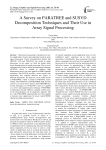
A Survey on PARATREE and SUSVD Decomposition Techniques and Their Use in Array Signal Processing
Статья научная
The present manuscript is intended to review few applications of tensor decomposition model in array signal processing. Tensor decomposition models like HOSVD, SVD and PARAFAC are useful in signal processing. In this paper we shall use higher order tensor decomposition in signal processing. Also, a novel orthogonal non-iterative tensor decomposition technique (SUSVD), which is scalable to arbitrary high dimensional tensor, has been applied in MIMO channel estimation. The SUSVD provides a tensor model with hierarchical tree structure between the factors in different dimensions. We shall use a new model known as PARATREE, which is related to PARAFAC tensor models. The PARAFAC and PARATREE both describe a tensor as a sum of rank-1 tensors, but PARATREE has several advantages over PARAFAC, when it is applied as a lower rank approximation technique. PARATREE is orthogonal, fast and reliable to compute, and the order of the decomposition can be adaptively adjusted. The low rank PARATREE approximation has been applied to measure noise suppression for tensor valued MIMO channel sounding measurements.
Бесплатно
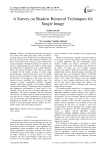
A Survey on Shadow Removal Techniques for Single Image
Статья научная
Shadows are physical phenomena that appear on a surface when direct light from a source is unable to reach the surface due to the presence of an object between the source and the surface. The formation of shadows and their various features has evolved as a topic of discussion among researchers. Though the presence of shadows can aid us in understanding the scene model, it might impair the performance of applications such as object detection. Hence, the removal of shadows from videos and images is required for the faultless working of certain image processing tasks. This paper presents a survey of notable shadow removal techniques for single image available in the literature. For the purpose of the survey, the various shadow removal algorithms are classified under five categories, namely, reintegration methods, relighting methods, patch-based methods, color transfer methods, and interactive methods. Comparative study of qualitative and quantitative performances of these works is also included. The pros and cons of various approaches are highlighted. The survey concludes with the following observations- (i) shadow removal should be performed in real time since it is usually considered as a preprocessing task, (ii) the texture and color information of the regions underlying the shadow must be recovered, (iii) there should be no hard transition between shadow and non-shadow regions after removing the shadows.
Бесплатно
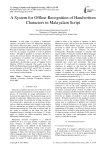
A System for Offline Recognition of Handwritten Characters in Malayalam Script
Статья научная
In this paper, we propose a handwritten character recognition system for Malayalam language. The feature extraction phase consists of gradient and curvature calculation and dimensionality reduction using Principal Component Analysis. Directional information from the arc tangent of gradient is used as gradient feature. Strength of gradient in curvature direction is used as the curvature feature. The proposed system uses a combination of gradient and curvature feature in reduced dimension as the feature vector. For classification, discriminative power of Support Vector Machine (SVM) is evaluated. The results reveal that SVM with Radial Basis Function (RBF) kernel yield the best performance with 96.28% and 97.96% of accuracy in two different datasets. This is the highest accuracy ever reported on these datasets.
Бесплатно
Статья научная
Encryption is used to prevent data from unauthorized access and with the appalling headway in network technology seen in the past decade; it has become the need of time to encrypt the images before sending over open network. Though researchers has proposed contrastive methods to encrypt images but correlation between pixels RGB value play a imperative part to guess for original image. So, here we introduce a new image encryption method which first rearranges the pixels within image on basis of RGB values and then forward intervening image for encryption. Experimentally it has shown that pixel rearrangement is enough from image encryption point of view but to send image over open network; inter-pixel displacement algorithm is applied to dispense more armament to image before transmission.
Бесплатно
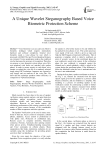
A Unique Wavelet Steganography Based Voice Biometric Protection Scheme
Статья научная
Voice biometric is an easy and cost effective biometric technique which requires minimalistic hardware and software complexity. General voice biometric needs a voice phrase by user which is processed with Mel Filter and Vector Quantized features are extracted. Vector quantization reduces the codebook size but decreases the accuracy of recognition. Therefore we propose a voice biometric system where voice file's non quantized code books are matched with spoken phrase. In order to ensure security to such direct voice sample we embed the voice file in a randomly selected image using DWT technique. Imposters are exposed to only images and are unaware of the voice files. We show that the technique produces better efficiency in comparison to VQ based technique.
Бесплатно
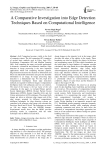
A comparative investigation into edge detection techniques based on computational intelligence
Статья научная
Soft Computing becomes visible in the field of computer science. The soft computing (SC) comprises of several basic methods such as Fuzzy logic (FL), Evolutionary Computation (EC) and Machine Learning (ML). Soft computing has many real-world applications in domestic, commercial and industrial situations. Edge detection in image processing is the most important applications where soft computing becomes popular. Edge detection decreases the measure of information and filters out undesirable information and gives the desirable information in an image. In image processing edge detection is a fundamental step. For this, high level Computational Intelligence based edge detections methods are required for different images. Computational Intelligence deals with ambiguous and low cost solution. The mind of the human is the key factor of the soft computing. In this paper, we included Binary particle Swarm Optimization (BPSO), Distinct Particle Swarm Optimization (DPSO), Genetic Algorithm (GA) and Ant Colony optimization (ACO) techniques. The ground truth images are taken as reference edge images and all the edge images acquired by different computational intelligent techniques for edge detection systems are contrasted with reference edge image with ascertain the Precision, Recall and F-Score. The techniques are tested on 100 test images from the BSD500 datasets. Experimental results show that the BPSO provides promising results in comparison with the other techniques such as DPSO, GA and ACO.
Бесплатно
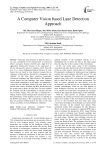
A computer vision based lane detection approach
Статья научная
Automatic lane detection to help the driver is an issue considered for the advancement of Advanced Driver Assistance Systems (ADAS) and a high level of application frameworks because of its importance in drivers and passerby safety in vehicular streets. But still, now it is a most challenging problem because of some factors that are faced by lane detection systems like as vagueness of lane patterns, perspective consequence, low visibility of the lane lines, shadows, incomplete occlusions, brightness and light reflection. The proposed system detects the lane boundary lines using computer vision-based technologies. In this paper, we introduced a system that can efficiently identify the lane lines on the smooth road surface. Gradient and HLS thresholding are the central part to detect the lane lines. We have applied the Gradient and HLS thresholding to identify the lane line in binary images. The color lane is estimated by a sliding window search technique that visualizes the lanes. The performance of the proposed system is evaluated on the KITTI road dataset. The experimental results show that our proposed method detects the lane on the road surface accurately in several brightness conditions.
Бесплатно
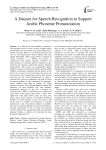
A dataset for speech recognition to support Arabic phoneme pronunciation
Статья научная
It is difficult for some children to pronounce some phonemes such as vowels. In order to improve their pronunciation, this can be done by a human being such as teacher or parents. However, it is difficult to discover the error in the pronunciation without talking with each student individually. With a large number of students in classes nowadays, it is difficult for teachers to communicate with students separately. Therefore, this study proposes an automatic speech recognition system which has the capacity to detect the incorrect phoneme pronunciation. This system can automatically support children to improve their pronunciation by directly asking children to pronounce a phoneme and the system can tell them if it is correct or not. In the future, the system can give them the correct pronunciation and let them practise until they get the correct pronunciation. In order to construct this system, an experiment was done to collect the speech database. In this experiment 89, elementary school children were asked to produce 28 Arabic phonemes 10 times. The collected database contains 890 utterances for each phoneme. For each utterance, fundamental frequency f0, the first 4 formants are extracted and 13 MFCC co-efficients were extracted for each frame of the speech signal. Then 7 statics were applied for each signal. These statics are (max, min, range, mean, mead, variance and standard divination) therefore for each utterance to have 91 features. The second step is to evaluate if the phoneme is correctly pronounced or not using human subjects. In addition, there are six classifiers applied to detect if the phoneme is correctly pronounced or not by using the extracted acoustic features. The experimental results reveal that the proposed method is effective for detecting the miss pronounced phoneme ("أ").
Бесплатно
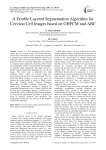
A double layered segmentation algorithm for cervical cell images based on GHFCM and ABC
Статья научная
Cancer is a life threatening disease and it engulfs the lives of many women. Due to the technology advancement, the medical science is drastically improved. A statistical report claims that the diagnostic decisions of radiologists show more false positive rates, which is very dangerous. However, when the radiologists are supported by computer aided applications, the false positive results are considerably reduced. Understanding the potentiality of computer aided applications, this paper presents a double layered segmentation algorithm for cervical cell images. The entire work is subdivided into three important phases, which are cervical image pre-processing, coarse and fine level segmentation. The pre-processing phase attempts to remove the noise and enhance the image quality by means of adaptive mean filter and Contrast Limited Adaptive Histogram Equalization (CLAHE) technique respectively. The coarse level segmentation process is achieved by Generalized Hierarchical Fuzzy C Means (GHFCM) and the fine level segmentation process is carried out by Artificial Bee Colony (ABC) algorithm. The performance of the proposed segmentation algorithm is analysed in terms of accuracy, sensitivity and specificity. The experimental results show the efficacy of the proposed segmentation algorithm.
Бесплатно
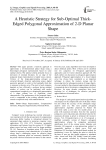
A heuristic strategy for sub-optimal thick-edged polygonal approximation of 2-D planar shape
Статья научная
This paper presents a heuristic approach to approximate a two-dimensional planar shape using a thick-edged polygonal representation based on some optimal criteria. The optimal criteria primarily focus on derivation of minimal thickness for an edge of the polygonal shape representation to handle noisy contour. Vertices of the shape-approximating polygon are extracted through a heuristic exploration using a digital geometric approach in order to find optimally thick-line to represent a discrete curve. The merit of such strategies depends on how efficiently a polygon having minimal number of vertices can be generated with modest computational complexity as a meaningful representation of a shape without loss of significant visual characteristics. The performance of the proposed frame- work is comparable to the existing schemes based on extensive empirical study with standard data set.
Бесплатно
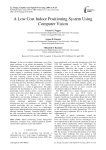
A low cost indoor positioning system using computer vision
Статья научная
In the era of robotics, positioning is one of the major problems in an indoor environment. A Global Positioning System (GPS), which is quite reliable system when it comes to outdoor environments and its accuracy falls in the range of meters. But for indoor environment, which requires a positioning accuracy in centimeters scale, the GPS cannot achieve this task due to its signal loss and scattering caused by the building walls. Therefore, an Indoor Positioning System (IPS) based on several technologies and techniques has been developed to overcome this issue. Nowadays, IPS becomes an active growing research topic because of its limitless implementations in a variety of applications. This paper represents the development of a low cost optical indoor positioning system solution where a static commercial camera is the only sensor. High accuracy in localization within the range of 1 cm is achieved. Detection, classification, and tracking techniques of an object are tested on mobile robots. The system is ideal for an indoor robotic warehouse application, where minimal infrastructure and cost parameters are required. The resulted positioning data are compared to the real measurement, and sent to the rovers via a lightweight broker-based publish/subscribe messaging protocol called Message Queuing Telemetry Transport (MQTT), where the only requirement between the client publisher and subscriber is the availability of a WLAN connection.
Бесплатно
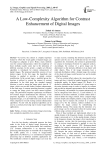
A low-complexity algorithm for contrast enhancement of digital images
Статья научная
As known, the contrast is a highly important feature by which the visual quality of digital images can be judged as adequate or poor. Hence, many methods exist for contrast enhancement, where the complexity of those methods usually varies due to the utilization of different concepts. In this article, a simple yet efficient algorithm is introduced for contrast enhancement of digital images. The proposed algorithm consists of four distinct stages: In the first stage, the hyperbolic sine function is applied to provide a simple contrast modification. In the second stage, a modified power-law function is utilized to control the amount of contrast adjustment. In the third stage, the standard sigmoid function is used to remap the image pixels into an “S” shape, which can provide further contrast enhancement. In the final stage, a contrast stretching function is applied to remap the image pixels into their natural dynamic range. The performed computer experiments on different low-contrast images demonstrated the efficiency of the proposed algorithm in processing synthetic and real degraded images, as it provided better and clearer results when compared to several existing contrast enhancement algorithms. To end with, the proposed algorithm can be used as a contrast processing step in many image-related applications.
Бесплатно

